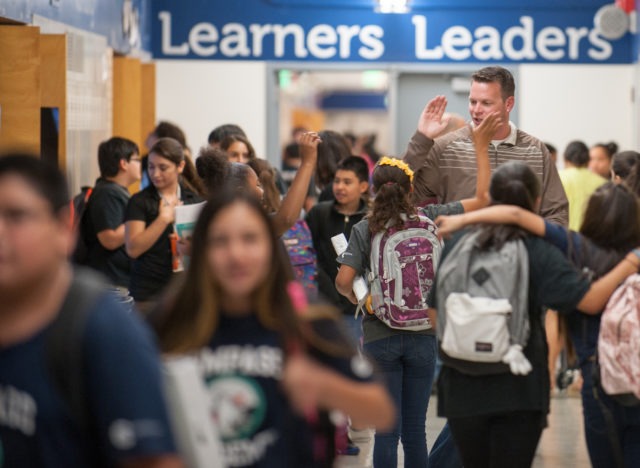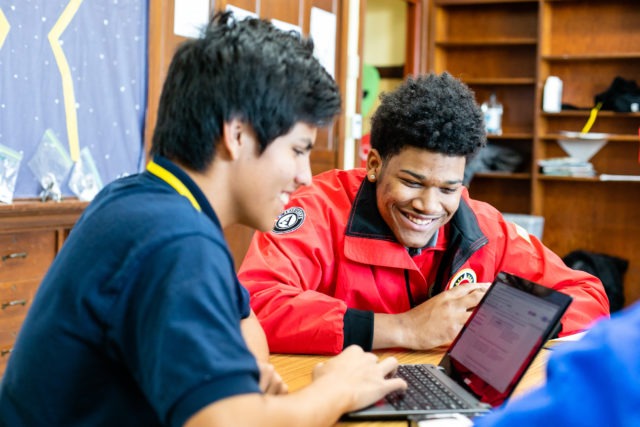How social-emotional skills keep students engaged

Social-Emotional learning in virtual classrooms
In a virtual classroom late last month, Santiago*, an outgoing sixth grader at Compass Academy, took time to think, write and share with his peers about gratitude as part of an online exercise that stretched his social and emotional skills—like the ability to express feelings—while strengthening bonds with schoolmates separated by COVID-19.
Compass, a charter public middle school in Denver, is recreating online a research-based strategy it practiced before the pandemic closed schools, when small groups of students and their teacher worked together regularly almost every morning on social and emotional skill-building that reinforced their sense of belonging and trust in one another. Now as absenteeism climbs across the country, Compass is finding these practices are paying off as students stay connected with peers and teachers and participating in online activities with their school community.
“Our social-emotional development work is an area where our kids feel very successful,” said Celine Wuarin, school design director at City Year, which co-founded Compass with the Johns Hopkins School of Education in 2015. “Keeping the momentum of learning and creating moments of success and celebration is keeping kids engaged in school.”
Prior to COVID-19, students would practice social and emotional skills—that research ties to academic success—with exercises like lining up at opposite ends of a beam and crossing to the other side at the same time as one of their peers. The exercise tested coordination, communication and the ability to read body language—and was designed to allow students to talk about feelings like failure in the safety of a small group when someone inevitably lost their balance on the beam and stepped onto the floor.
“All of this is really about relationships,” said Brandon Jones, senior dean of instruction at the school, where about 90% of students were in regular contact with teachers last month. “How do you build trusting relationships that can turn into creating a vulnerable space where students can express feelings, needs and concerns in a way where they don’t feel like they’re going to be judged.”
School absenteeism and COVID-19
According to an April survey by the EdWeek Research Center, teachers in classrooms with larger shares of students from low-income families reported higher rates of students not logging in or being in contact—suggesting how the pandemic can deepen systemic inequities in education, housing and healthcare that impact young people, including students from lower-income households and students of color.
At Compass, 94% of students qualified for government-funded school meals this school year, compared with 65% across Denver Public Schools, according to its Oct. 2018 data. About 64% of Compass students are English language learners, compared with 36% across Denver Public Schools.
Together with local leaders in the Denver community, City Year and Johns Hopkins School of Education launched Compass based on an education model that makes strong school relationships a fundamental part of learning, strengthens students’ academic and social and emotional skills, and integrates a bilingual and biliterate focus.
Students also receive support from a team of City Year AmeriCorps members who collaborate with teachers and have helped to engage students online. The model aims to keep more students on track to graduate high school and be replicable to schools across the country.
Across Colorado, 73% of Hispanic students graduated high school on time in 2018, about 12 percentage points lower than the rate for white students, according to state data. Prior to the pandemic, more than 54,000 school age children in the state had no access to the internet, many of them in Hispanic households and in lower-income households, according to a recent study by the Colorado Futures Center at Colorado State University in Fort Collins.
At Compass, almost all the students have working Chromebooks and internet access, in some cases through hot spots delivered to them by school staff shortly after schools closed, Jones said.
By the end of the recent classroom exercise, the group of Compass sixth graders had produced short letters thanking someone like a first responder or parent and shared their thoughts about the letters with each other through a crowded Zoom screen and the chat function.
Santiago, who is quick to smile and loves to draw, wrote a note in Spanish thanking his father for working so hard for his family, he said via Zoom from a small and brightly painted room in his apartment, where his younger brother sometimes mugged for the camera. He regularly attended his online classes in April at Compass, according to school data.
Writing letters and other ways of showing gratitude fosters emotional development and can help buoy well-being—especially during periods of increased stress.
“We know through research and science that the greatest way to create happiness for yourself is to show gratitude to others,” Jones said. “And those are things that we try to teach.”
Jones is working with faculty to adapt social and emotional learning activities so students can practice them at home.
Staying in touch during the pandemic
Prior to COVID-19, watching the students’ reactions in person had helped guide the lesson—which teachers find tougher online since some students are reluctant even to turn on their video cameras.
“Not all kids want their friends or their teachers seeing their environment around them at home,” said Kim Rodriguez, a math teacher. “We always try to plan things where showing their faces isn’t completely necessary.”
To make it easier to participate, the school is experimenting with ways for students to show their emotions, for example by drawing an emoji to hold up to the screen.
The school also is encouraging students to take advantage of the social and emotional skills they learned earlier in the year to manage at home. Overcoming discomfort at showing other kids what their home looks like via Zoom can be an exercise in positive risk-taking, for example.
Students also can rely on the social and emotional skills they’ve learned to help them recover more quickly once schools reopen, said Wuarin, a former special education teacher at Compass who focuses on social and emotional learning innovation at City Year.

Teachers finding new ways to support students
“The social-emotional learning is just as important as academics in terms of getting kids ready to say `I have the tools that I need to go back to school. I know that I lost learning, but I know how to set my goals; I know how to communicate positively, so I have all these skills that I need to re-engage.’’’
At Compass, teachers are staying in touch with students and their parents through regular text messaging, phone calls and an online learning platform, and reaching out to families when students aren’t completing their assignments.
Seventh grader Rachel*, who loves art and science, said she’s finding classwork harder to complete online because asking questions is more difficult than when she could just raise her hand. But she looks forward to talking regularly online with her classmates and is more comfortable and talkative at Compass than her prior school, and closer to teachers, she said.
“The students see how much effort the teachers are putting into keeping them focused and interested,” said Shanelle Mawson, the mother of an eighth grader at Compass. “The emotional support that they give students is so sincere.”
Getting creative during COVID-19
Some skill-building exercises have been easier than others to translate online—a group of students who regularly worked together on teamwork and collaboration by putting together a weekly video of news about their school are doing the same project together now—just from home. A recent video shared across the school included a weather report, a quiz about pandemics, a Spanish-language segment and dancing.
Jones also is learning from an unexpected outcome of online classes—like how some students complete more of coursework now than they did when school was open.
“A traditional school setting can’t support them, but they love this,” he says. “They’re thriving in distance learning.”
*Students’ names changed to protect privacy.
Are you and educator or a parent? Find out more about how to incorporate social and emotional skill-building into learning by using this guide created by City Year.
Related stories
Over the last few months, City Year Memphis and their local Starbucks partners—along with several other community organizations, businesses and...
Read more about Creating hope and opportunity in Memphis through partnershipsIn recognition of Financial Literacy Month, City Year AmeriCorps members are exploring the importance of financial literacy for young people’s...
Read more about Understanding the importance of equitable access to financial literacyIf you speak with an HBCU alum about their experience, you’ll quickly learn that service to the community is one...
Read more about Diversity, leadership and community: reflections of an HBCU alumDo you know about the vibrant city of Kansas City and the incredible opportunities it offers to City Year AmeriCorps...
Read more about Seven reasons to serve with City Year Kansas City















